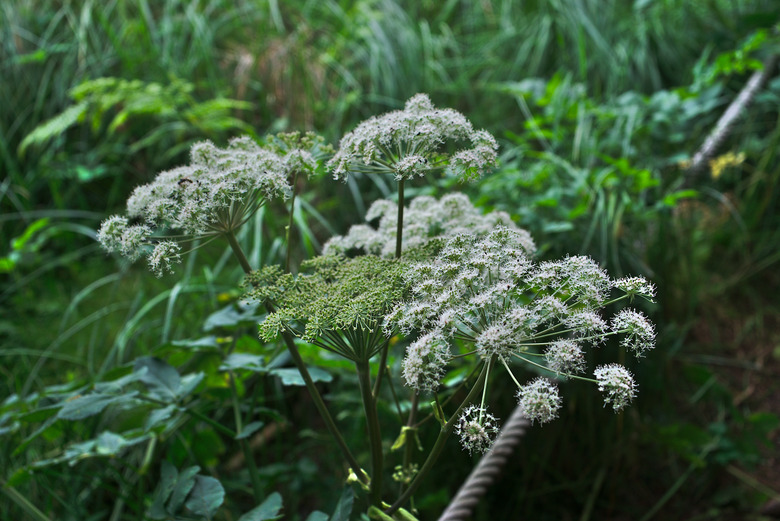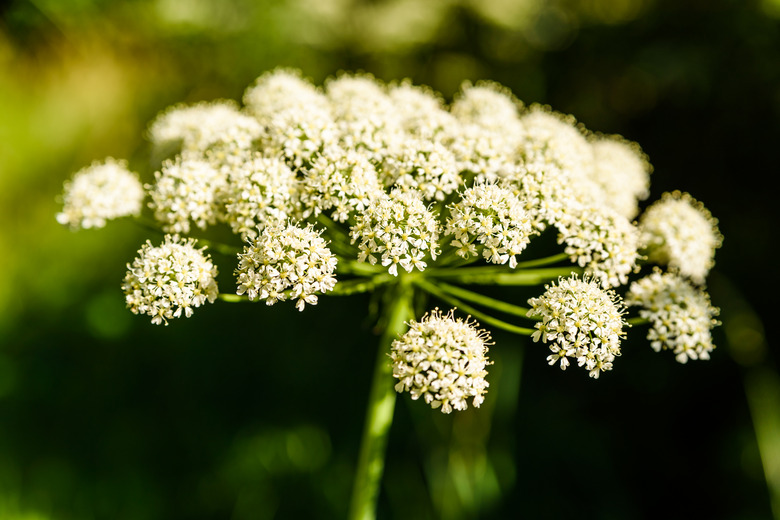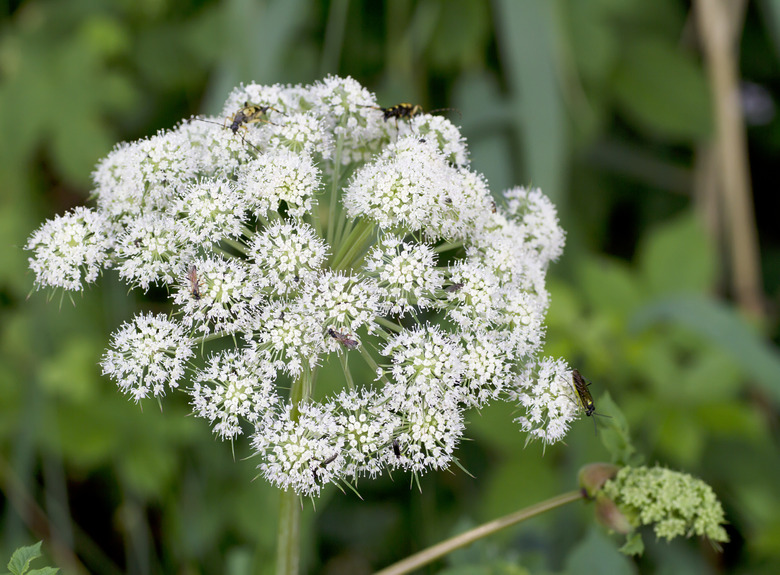How To Grow Angelica
Angelica (Angelica archangelica, USDA zones 5-8) is a tall, biennial, medicinal herb that grows between 6 and 8 feet tall with celerylike stalks in shades ranging from red to green. The plant has no stem at all in its first year; it has just a large clump of divided leaves approximately 3 1/2 feet tall. Then, in the second year, the hollow, thick stalk will sprout up, and starting in early summer, it will grow large, lacy umbels of yellow-green flower heads about 10 inches wide.
When the flowers die away in late summer, the plant will develop green fruits that will turn beige when ripe and will eventually drop small seeds to the ground. While it can sometimes be a challenge to start angelica plants, once they get going, they are easy to care for, as they are frost tolerant and can survive under many growing conditions.
Best Uses for Angelica
Also known as holy ghost, garden angelica, angel's herb, root of the Holy Spirit, wild celery and Norwegian angelica, this plant is part of the Apiaceae (also known as Umbelliferae) family, which also includes herbs such as dill, cilantro and parsley as well as vegetables like celery, carrots and parsnips.
The Latin name Angelica archangelica comes from a widespread legend about the plant. In 1665, the archangel Michael appeared to a monk in a dream, telling him the plant could be used to help cure the plague that was ravaging Europe. Indeed, angelica was widely used as a plague remedy throughout the Medieval period, and the herb was said to be able to treat just about any disease, ranging from toothaches to snakebites.
These days, though it might not be used as a cure-all, the angelica herb still has a surprisingly long list of medicinal uses. In fact, it may help treat heartburn, gas, joint pain, stroke, dementia, lung problems, runny nose, anxiety, nervousness, fever, insomnia, nerve pain, cramps and circulation problems. Always speak to a doctor before using any herbal remedy. Pregnant women should avoid using or eating any part of the plant, as it may cause miscarriage.
While it is best known for its medicinal properties, angelica also has a number of culinary uses. The sweet stalks are often candied or jellied, the fruits are used for teas, the bitter leaves can be served with fish and angelica root can add a juniperlike flavoring to gin, Chartreuse and other liqueurs. That being said, you should never attempt to harvest wild angelica, as it is nearly identical to poisonous water hemlock. Even when eating angelica you grew in your own garden, practice moderation because consuming large amounts can cause photosensitivity.
The good news is that it is fairly easy to grow. It can thrive in large pots (be sure the pots are placed where they have enough space to grow 6-foot-tall herbs, though) and is an attractive and aromatic addition to any herb garden. It's also a great way to attract bees to your garden, as they love the strong smell of the massive flowers.
How to Grow Angelica
- Common Name: Angelica, wild celery
- Botanical Name: Angelica archangelica
- When to Plant: Late summer, early
fall or early spring - USDA Zones: 5-8
- Sun Exposure: Partial shade or full sun
- Soil Type: Well-drained but
moist loam - When it's in Trouble: Leaves wilt, growth
is stunted, mold grows on leaves, foliage develops splotches or squiggly lines,
leaves yellow - When it's Thriving: Grows healthy green leaves 2 to 3 feet long, and in the second year, it should have a red to green
stalk that grows 6 to 8 feet tall, which develops large, lacy green or yellow
flowers
Starting Angelica From Seed
The best way to start angelica is with freshly harvested seeds, as these will increase germination rates and seedling viability. If you don't have access to a living angelica plant in order to get fresh seeds, though, you can purchase them, but you'll want to sow extra seeds to ensure you achieve high-enough germination rates. This is also the case if you chose not to plant your seeds when they were fresh in late summer or early fall and instead stored them to sow in early spring.
For best results with stored seeds, you'll need to do heavy stratification (essentially recreating a seed's natural environment) to prepare the seeds for growth. Start by refrigerating the seeds a few weeks before planting. For fresh seeds, you can sow them immediately or refrigerate for up to a week before sowing. Start plants in small pots so they can be transplanted as seedlings.
Sow seeds by gently pressing them into the surface of the soil. Do not cover them with soil, as angelica seeds require light to germinate. Maintain moist soil until germination, which will be around 30 days. Because the plants do best with fluctuating temperatures, seed pots usually do best outside but be sure to bring them inside if you're expecting a freeze. If you must keep them inside, place pots in a sunny location, ideally with temperatures that are above 60 degrees Fahrenheit.
When seedlings reach 3 to 4 inches, they'll need to be replanted. Do not wait to transplant once your plants grow taller than 4 inches, however, as angelica plants are particularly prone to transplant shock. Space seedlings 12 to 24 inches apart in rows that are 36 inches apart and choose an area for planting where the plants will be protected from heavy winds that may knock down the tall stalks.
Once this hearty plant is established, it is likely to survive short dry periods and below-freezing weather. To help your plant survive cool winters, avoid watering as winter approaches. Foliage will die off in the winter and grow back in the spring of the following year. The plant will die after flowering and fruiting. This usually occurs at the end of its second year, but some people have had success in extending the plant's life by an additional year by cutting off the flower stalks before they go to seed.
In What Zone Does Angelica Grow Best?
Angelica grows as a perennial in USDA zones 5 to 8, but it can sometimes survive in zones 3 and 4 as well. It does not tend to do well in the South, though, as it is a cold-weather plant and does poorly in warm, humid areas. Interestingly, while angelica will live two years in most areas, it may live longer in particularly cold regions, not maturing or flowering until its third or fourth year.
When deciding where to grow angelica, consider your region. In general, the plant prefers partial shade, and this is particularly true in warmer areas, but in cooler regions, full sun may be preferable.
When Should You Plant Angelica?
Angelica's natural life cycle results in the seeds being naturally sown when they have fallen off the plant in late summer or early fall. If you can get access to these seeds, this is the best time to sow them since it means your seeds will remain fresh.
When working with stored seeds, you can still start in late summer or early fall, but you may also choose to sow them in early spring. This generally requires more stratification to kick-start the seeds into their growth phase.
Whether working with fresh or stored seeds, if you sow in spring or summer, germination will usually take 30 days, but in fall, it may sometimes be delayed until after winter.
Soil, Sunlight and Water Recommendations for Angelica
Overall, angelica prefers well-draining loamy soil that is slightly acidic, enriched with organic material, and lightweight. That being said, it can grow well in just about any kind of soil. The most important factor is that the soil is at least 12 inches deep since the plant's long taproot will often reach down 10 inches.
Angelica is also pretty forgiving when it comes to sunlight. It prefers partial shade, but it can do just fine in full sun and may even do better with full sun in cooler regions.
While angelica may survive short periods of dryness, it naturally grows in wet areas and does not tolerate drought. This means you should always keep the soil moist. Do not overwater, though, or you may contribute to fungal growth that could kill the plant. For best results, mulch heavily to prevent water evaporation from the soil. If you mulch with compost, this can also help fertilize your plants, but alternatively, consider side dressing once a month with a 10-10-10 fertilizer.
How to Propagate Angelica
One of the great things about angelica is that it self-seeds incredibly easily. If you want more plants without doing any work, you can just let the flowers bloom, fruit and drop their seeds naturally. For best results with self-seeding, pull back your mulch before the seeds drop to ensure they drop directly on your soil.
If you want more control over where and when the plants grow, it's easy to collect the seeds. Simply tie a paper bag over the flower heads when they fade and leave for a month or so. After the flowers turn into fruits, they'll release seeds that will fall right into your bag. These can then be stored in a jar in your refrigerator until you are ready to plant again.
It's also possible to propagate angelica through root division. Wait until the fall of the first year after the plant has gone dormant. Then, cut back the plant so it is only a foot tall. Use a sharp spade to divide the plant down the center, leaving one half of it in place, or dig up the whole plant and then divide the roots into two or three sections. Replant each root section in a garden bed spaced 18 to 24 inches from one another.
How to Harvest Angelica
Because nearly every part of this plant is used for food or medicine, it's important to know how to harvest each part without hurting the plant. Leaves should be taken in the first year or in spring of the second year, being careful not to damage the main stem or to overharvest. You can start harvesting only a few months after planting. Because they do not store well, it's best to take leaves as needed.
Roots should be taken in the dormant period after the first year or in early spring the next year. Only take 1/3 of your crop for roots so the rest can go to seed. Roots can also be harvested after the plant has seeded, but they are not as tender and are more difficult to dig up.
Shoots should be harvested when they are still young and tender in the early part of the plant's second year. Do not harvest more than 1/3 of your crop so you can ensure the plants can self-seed.
Wait until fruits turn beige to harvest and then trim off clumps of seeds so they land in a paper bag and can be separated from the stems on your table inside.
Common Pests and Other Problems for Angelica
Overall, angelica is a healthy plant that is susceptible to few pests and diseases. In fact, the main problem people encounter when growing the angelica herb is aphid infestation. This may cause leaves to wilt and the entire plant to become stunted. Aphids may also leave behind a sticky residue that can cause mold growth on the leaves. The best way to get rid of aphids is to dislodge them from your plants with a stream of water.
Leaf miners are another insect that may damage your angelica. They eat through the foliage when in their larval stage, leaving spots or squiggly lines on the leaves. To eliminate these pests, apply neem oil to the leaves following all label recommendations.
Common Diseases of Angelica
While angelica isn't susceptible to most diseases, it can be damaged by crown rot. This is a fungal disease that infects soil, causing rotting at the base of the plants. If infected, plants will turn yellow, wilt and eventually die. This disease can't be treated once it affects your plants, so instead, efforts should be taken to prevent its spread. This starts by amending heavy clay soils with compost and not overwatering plants since excessive moisture contributes to fungal growth. Growing your plants in raised beds improves drainage and minimizes the threat of root and crown rot.
If you notice an infection, remove and dispose of the diseased plants immediately. Then, kill off the fungus in the soil by heating it. This can be done by covering the soil with plastic and leaving it until the next summer has passed.


